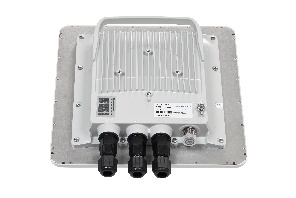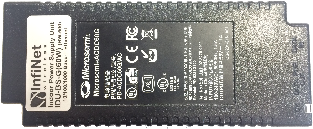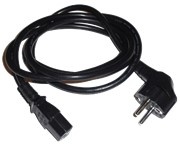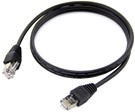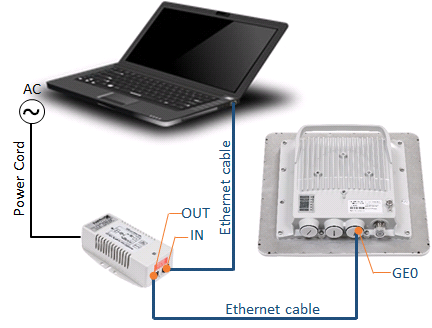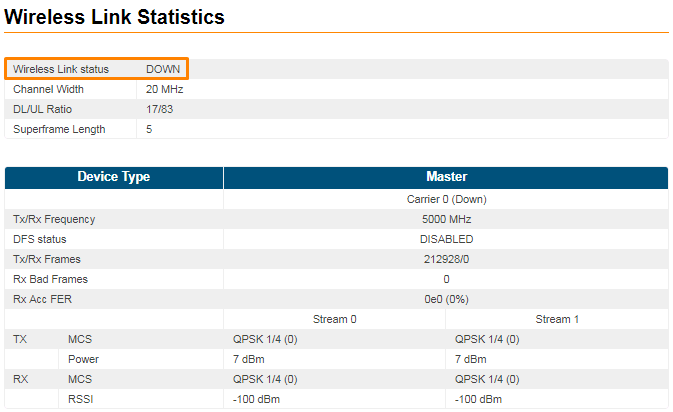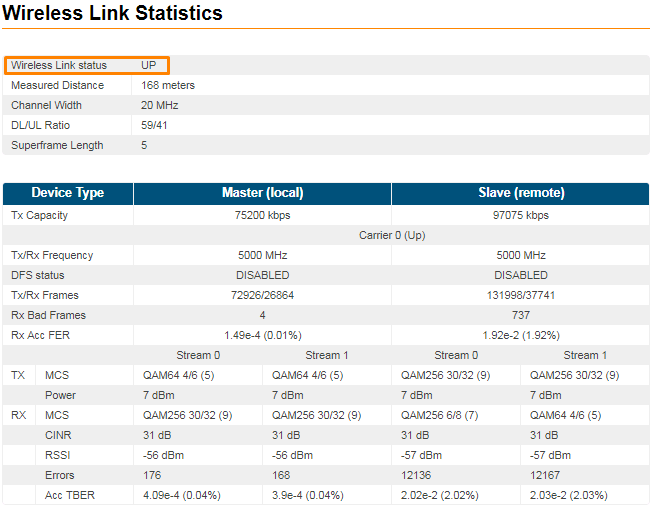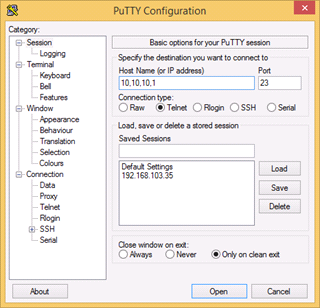In order to initially setup an operational point-to-point link you must run the procedure described below.
Step 1 - Perform site survey
- Use InfiNet Wireless link planner tool InfiPLANNER to estimate link performance and required configuration in terms of antennas, channel width, Tx power, etc.
- Determine line of sight conditions and obstacles along the path
- Perform spectrum analysis and figure out spectrum occupation and available channels
ВНИМАНИЕ
InfiPLANNER is available via https://infiplanner.infinetwireless.com.
Step 2 - Pre-configure the units in the lab
The equipment list required for lab configuration
| Component | Description |
|---|---|
| |
| |
| |
| |
|
In the lab and later on site perform the connections as indicated below:
- Connect laptop to the IDU port labeled as "IN" with an Ethernet cable.
Use another Ethernet cable to connect "GE0" port at the ODU to the IDU port labeled as "OUT".
- Use power cord to connect the IDU to AC mains.
After the physical connections are completed, perform settings of each unit described below.
Units settings can be performed via:
Settings via web interface
| Step 1 |
|---|
Access the unit to the default IP address 10.10.10.1 with mask 255.255.255.0 via web browser. Make sure that the Ethernet port of the Laptop has an IP address assigned from the same network class as the one for the unit (for example, set 10.10.10.50 with mask 255.255.255.0). |
| Step 2 |
Use any letters or numbers for initial authentication, for example:
NOTE After the initial login to the units, it is recommended to change the user and password to more secure permanent values. |
| Step 3 |
Enter to the unit. Initially the status of the radio link is DOWN like below.
Figure - Initial link status |
| Step 4 |
Upgrade the units to the newest available firmware. |
| Step 5 |
Perform radio settings. Go to the "Radio" section and set the following parameters:
NOTE Make sure that both units are configured with maximum Tx power. NOTE The detailed description for each radio setting can be found in the section "Radio". CAUTION Please note that the following parameters must have the same values at each of the two units in the PtP link. Otherwise the wireless link between them won’t be established:
|
| Step 6 |
Save the configuration, reboot both units and check if they link up after reboot. The link status should be UP and the radio statistics should indicate the capabilities and quality of the link. Figure - Link UP status |
Settings via CLI
| Step 1 | |||||||||||||||||||||||||||
|---|---|---|---|---|---|---|---|---|---|---|---|---|---|---|---|---|---|---|---|---|---|---|---|---|---|---|---|
CLI is available via telnet: "cmd> telnet 10.10.10.1" or use any suitable telnet client such as Putty. | |||||||||||||||||||||||||||
| Step 2 | |||||||||||||||||||||||||||
Use any letters or numbers for initial authentication, for example:
NOTE After the initial login to the units, it is recommended to change the user and password to more secure permanent values. | |||||||||||||||||||||||||||
| Step 3 | |||||||||||||||||||||||||||
Chech the firmware version and upgrade the units to the newest available firmware if necessary. You can check firmware version via command: xginfo version Compare current version of the unit with version on official InfiNet ftp server: ftp://ftp.infinet.ru/pub/Firmware/XG/H12. In case of newer version is available it is recommended to upgrade the firmware. | |||||||||||||||||||||||||||
| Step 4 | |||||||||||||||||||||||||||
Configure radio parameters.
NOTE Make sure that both units are configured with maximum Tx power. NOTE Commands description is given in the section "Commands for modem configuration". CAUTION Please note that the following parameters must have the same values at each of the two units in the PtP link. Otherwise the wireless link between them won’t be established:
NOTE In order to synchronize the units settings, copy from one unit and paste to another the "Peer exported config" line shown in the "xg config -peer-exported" command output. See the configuration example below: #Peer exported config: xg -v3-start xg -v3 a01b833402f59907abdcb812d5de20fd.Ko7ClHTRVps/8oyNjnucBcSqUlcCJbOae9Kf4OZ xg -v3 zRU7tYm1REMTUyHWYTaGGuuooDp2DWkcxyFGLmEb5yx45wFImL5Nx72XK6bnl9AzRdZjWVSN xg -v3 xCrliSUfn7JZazn1yTEKE90fKLIK/HKNJXYN7vg4lEocgBWguYdFc/u8fEwENtJYBSKNGbu3 xg -v3 HQ0HvIdTqAwOz5vXM89CkhL5ZZmDuYN3FFSo6wV+h//zBuSfuJ5QVb6fv2Do6tPIE4kuZSsB xg -v3 UXLavUriPtSlRxzIYUO7+9XSMggomrf7NZtM37PxQkUYIZ116K3++w5HPVXXq8Po7xVmotnq xg -v3 px1uDbYtSjs2O9yx6h6Z0HGp8GLAEY7Ka5ZRoyAvyfA73pobYrEhzZ+hdwWnDDJYM3DmAhuW xg -v3 yAUgtVHJ4hC9u6BP5IAlQXsm5QSbuRwihWdmrwiThwSGmXiZWCXOmxzg1IA== xg -v3-end | |||||||||||||||||||||||||||
| Step 5 | |||||||||||||||||||||||||||
Save configuration. config save | |||||||||||||||||||||||||||
| Step 6 | |||||||||||||||||||||||||||
Restart the unit. restart yes | |||||||||||||||||||||||||||
| Step 7 | |||||||||||||||||||||||||||
Check the link establishment. Sys log show | grep UP In case of success configuration: [XG]: changed state UP->DOWN |
Step 3 - Perform Initial Antenna Alignment
- Install both units on the pole and direct them at each other (more detailed information about units installation and antenna alignment is described in the section "Units Installing")
- Turn them on and make sure that the units subsystems are working properly. This can be done by LED indication.
| LED | Normal state | Function |
|---|---|---|
| Power | On | On - power is applied to the device Off - no power is applied or improper power source |
| SYNC | On | TDD-synchronization |
| SFP | On | Ethernet link |
| GE1 | On | Ethernet link |
| GE0 | On | Ethernet link |
| RF | On | RF link. Blinking while establishing RF link |
- Perform coarse alignment using built-in signal strength indicators
NOTE
The more indicators are on, the better wireless connection is established. The blinking indicator means an intermediate state. The more often the indicator blinks the higher level connection is established.
- Perform fine alignment using the "Alignment tool" available in the Web interface or "xginfo stat" output in the CLI. Try to maximize CINR and RSSI readings. Please follow the detailed indications from section Antenna alignment for a proper antenna alignment.
NOTE
If “Absolute RSSI” value goes above -40 dBm, decrease "Tx power" at the opposite side in order to keep it within -40...-50 dBm for the best performance.
Step 4 - Optimize the link performance
- Adjust maximal link distance parameter based on the measured distance.
NOTE
Check measured link distance from the "Status" page or using "xginfo stat" command output and set the parameter in the "Max Distance" field or with "xg -max-distance" command.
- Monitor air block error rate by checking the Acc TBER parameter in the "Status" page or in "xginfo stat" output and adjust the AMC strategy if necessary.
NOTE
Acceptable error rate depends on the application. See some examples in the table below.
| Application | Acceptable error rate |
|---|---|
| TCP-based applications (web, FTP, etc.) | 10-4 |
| Voice-over-IP | 10-5 |
| UDP video (CCTV, IPTV, etc) | 10-6 |
| TDM-over-IP | 10-7...10-9 |
- “normal” AMC strategy is enabled by default.
- “aggressive” AMC strategy has been designed to maximize the throughput by utilizing higher-order modulation schemes and reducing SNR margins.
- “conservative” AMC strategy increases SNR margins, so that lower order MCSs are used in order to keep error rates to the minimum.
It is recommended to use “normal” strategy initially and adjust it based on target and actual TBER values.
- Fine tune the "Tx power" in order to optimize the CINR and RSSI values. These parameters can be monitored in real time from the "Status" page and the recommendation is to keep the RSSI between -40…-60 dBm and the CINR higher than 30 dB
- Select the most appropriate air frame period.
